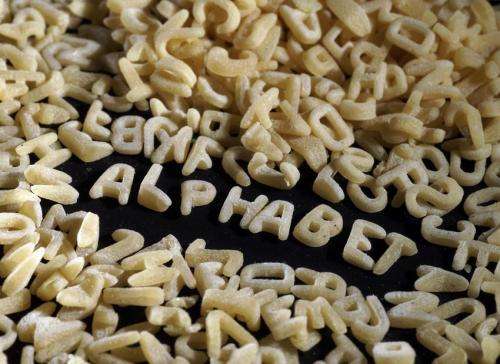Neuroscientists discover adaptation mechanisms of the brain when perceiving letters of the alphabet

The headlights – two eyes, the radiator cowling – a smiling mouth: This is how our brain sometimes creates a face out of a car front. The same happens with other objects: in house facades, trees or stones – a "human face" can often be detected as well. Prof. Dr. Gyula Kovács from Friedrich Schiller University Jena (Germany) knows the reason why. "Faces are of tremendous importance for human beings," the neuroscientist explains. That's why in the course of the evolution our visual perception has specialized in the recognition of faces in particular. "This sometimes even goes as far as us recognizing faces when there are none at all."
Until now the researchers assumed that this phenomenon is an exception that can only be applied to faces. But, as Prof. Kovács and his colleague Mareike Grotheer were able to point out in a new study: these distinct adaptation mechanisms are not only restricted to the perception of faces. In the The Journal of Neuroscience the Jena researchers have proved that the effect can also occur in the perception of letters.
The basis for this is the neuronal plasticity of the brain, which allows us to adapt to environmental stimuli. "The more often we are exposed to a certain stimulus, the quicker we perceive it," Mareike Grotheer, doctoral candidate in Kovác's team says. This "training effect" could be measured directly in the brain. As magnetic resonance imaging shows, environmental stimuli which the brain has already adapted to, lead to distinctly lower responses in the processing areas. "This might sound paradoxical at first, but it only means that the brain arrives at the same result with less effort," Kovács points out.
This adaptation mechanism is particularly pronounced in situations when we expect a very specific stimulus. "Our past experiences are essential in shaping our sense of perception," Kovács stresses. For the recognition of characters experience also plays a decisive role. Practically we are surrounded by characters everywhere: in the media, in the streets, on everyday objects.
In their study the researchers showed different characters to test persons and recorded via functional magnetic resonance imaging the brain activity which was set into motion by the process of seeing. "The recordings clearly show that the brain activity adapts to the visual perception of characters in the course of the measurements," Kovács says. However, this only applies to correct roman characters. The Jena researches were not able to detect a similar adaptation in a parallel test series with false, altered characters.
It stands to reason, Prof. Kovács sums up, that the reading and writing experience of a test person is responsible for this adaptation. It is not yet clear, if the adaptability of the brain can be specifically trained to the recognition of characters or if it is the result of evolutionary development processes – which is the case with the recognition of faces: This has to be shown in future research.
More information: Grotheer M, Kovács G. Repetition probability effects depend on prior experiences. The Journal of Neuroscience 2014 DOI: 10.1523/JNEUROSCI.5326-13.2014
















